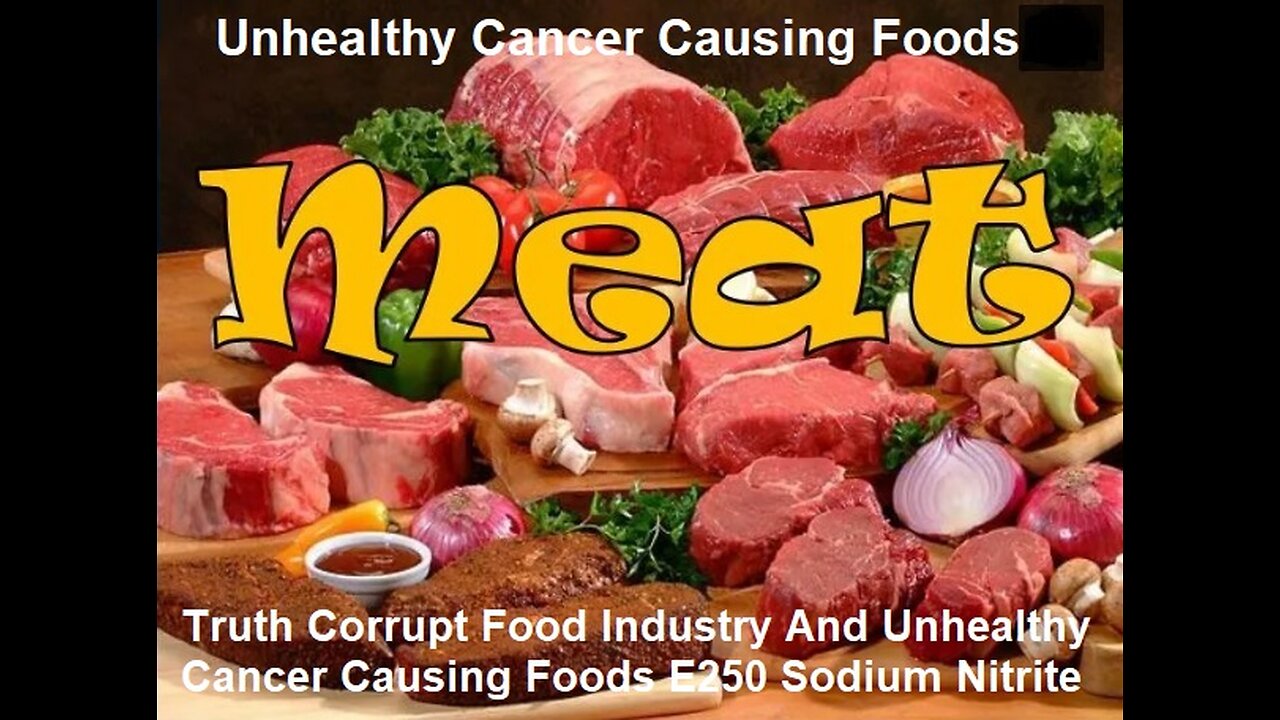Premium Only Content

Corrupt Food Industry And Unhealthy Cancer Causing Foods E250 Sodium Nitrite
How the Meat Industry Hides the Truth and Corrupt Food Industry Well we’ve all seen the words nitrates or nitrites in processed meat labels. More recently there’s been wave of food manufacturers trying to peddle their products with the advantage of being nitrites free… You may even have come across some cured meat products that say that they have been mixed with celery juice to replace nitrites (Celery juice being a source of natural nitrates). But what is sodium nitrite, what does it do in cured meats and more importantly: Is it bad for you?
11 Unhealthy, Cancer Causing Foods – Backed by Science
Cancer is a disease that can arise from numerous factors. Although diet plays an important role in causing cancer, one should never disregard the fact that lifestyle and exposure to environmental chemicals can also increase one’s chance of developing cancer.
Statistics disclose that over 50% of cancer cases are caused by lifestyle and the most influential lifestyle factor that can lead to cancer is the drink and food people consume frequently.
Here are some of the top unhealthy cancer-causing foods that should be avoided:
1. Artificial Sweeteners
Artificial sweeteners, also called sugar substitutes, are compounds that are used instead of sucrose (table sugar) to sweeten beverages and foods. Because artificial sweeteners are many times sweeter than table sugar, lesser amounts are needed to create the same level of sweetness.
Today artificial sweeteners and other sugar surrogates are found in a variety of beverages and food; they’re marketed as „diet” or „sugar-free”, including fruit juice, chewing gum, soft drinks, jellies, baked goods, candy, and ice yogurt and cream.
These artificial sweeteners included the „first generation” sweeteners such as cyclamate, saccharin, and aspartame, as well as a „new generation” sweeteners such as sucralose, acesulfame-K, neotame, and alitame.
There have been more reports to the FDA for aspartame side effects than for all other food additives combined. And, there are over 900 published studies on the health hazards of aspartame.
A positive connection between the use of artificial sweeteners, especially saccharin, and risk of bladder cancer in males has been observed in a case-control study of 152 women and 480 men in three provinces in Canada.
2. Genetically-modified organisms
What’s the concern? Many people believe that altering the DNA of an animal or plant has a significant effect on a person’s chances of developing cancer.
According to the World Health Organization, genetically modified organisms (GMOs) are „organisms in which the genetic material (DNA) has been modified in such a way that it does not occur naturally.” Scientists insert a gene from one organism into another to „change” or „improve” the organism.
One research carried out by Caen University in France, which has been peer-reviewed by independent scientists to guarantee the studies were properly conducted showed that up to 70% of females and 50% of males suffered a premature death, rats fed GM corn and traces of Roundup suffered severe organ damage including kidney damage and liver damage and tumors in rats of both sexes fed the GM corn was 2 to 3 times larger than in the control group.
„It shows an extraordinary number of tumors developing earlier and more aggressively – particularly in female animals. I am amazed by the extreme negative health impacts.” – Dr Michael Antoniou’s quote.
3. Alcohol
Six Health Benefits Of Drinking Spiced Rum
The last thing anyone wants to hear is that alcohol is a cause for cancer, but alcoholic beverages are classified by the International Agency for Research on Cancer (IARC) as a Group 1 carcinogen (carcinogenic to humans).
IARC classifies regular alcoholic beverage consumption as a cause of liver, colorectum, female breast, oral cavity, larynx, pharynx and esophagus cancers. In addition, also as a probable cause of pancreatic cancer.
The World Cancer Report released in 2014 highlighted the role of alcohol in cancer, finding that it accounts for 3.5% of cancers (about 1 in 30 cancer deaths) globally.
New studies have shown that even small amounts of alcohol can increase the risk of bowel cancer. An ongoing study of 500,000 people in ten European countries has found that for every 2 units drunk a day, your risk of bowel cancer goes up by 8%.
4. Meat
meats
The IARC looked at more than 800 studies on the connection between processed and red meat and cancer risk and determined that every 50-gram portion of processed meat eaten daily increases the possibility of colorectal cancer by 18%.
The American Institute for Cancer Research (AICR) and the World Cancer Research Fund have also concluded that eating even small amounts of processed meats on a daily basis can increase colorectal cancer risk.
Studies show that compared to eating no processed meat, eating 3.5 ounces daily (just a large hot dog), increases colorectal cancer risk by 36%.
5. Dairy Products
The fact that we require calcium (Ca) is a poor reason to say we must drink milk because heat or pasteurization renders the Ca practically unassimilable and of very little use to the human body.
The average American gets 807 mg of Ca a day from drinking milk. Compare that to daily averages in Brazil (250 mg), Spain (308 mg), Ghana (8 mg), and Taiwan (13 mg). People in these countries get their Ca from other sources like spinach, broccoli, kidney beans, soybeans, almonds, rhubarb, turnips, collards.
If you still believe you must drink milk to make your bones strong, here’s a compelling fact: the 5 highest dairy-consuming countries (Sweden, Finland, United States, U.K., and Israel) also have the 5 highest rates of hip fracture, a sign of osteoporosis.
A recent study from Clemson University represents the other extreme, controlling for as many aspects as possible by isolating prostate cancer cells out of the body in a petri dish and dripping cow milk on them directly.
The scientists chose organic cow’s milk, because they wanted to exclude the effect of extra hormones so that they could test the effect of all the growth hormones and sex steroids found naturally in milk.
They discovered that cow’s milk stimulated the growth of human prostate cancer cells in each of fourteen separate experiments, producing an average increase in the cancer growth rate of over 30%. In contrast, almond milk restrained the growth of these cancer cells by over 30%.
„We have all been brought up with the idea that milk is good for you. But there is evidence now that the growth factors and hormones it contains are not just risky for breast cancer, but also other hormone-related cancers, of the prostate, testicles, and ovary.” – Prof Plant’s quote.
6. Eggs
About 2 million men in the United States are living with prostate cancer. Eggs have zero (0) dietary fiber and about 70% of their calories are from fat, a big portion of which is saturated.
Eggs are the most concentrated usual source of choline in the American diet, which may increase the risk of cancer emergence, spread, and lethality.
The World Health Organization examined data from 34 countries in 2003 and found that eating eggs is linked with death from rectal and colon cancers.
In a Harvard study, entitled Choline Intake and the Risk of Lethal Prostate Cancer, found that those with the highest choline intake had a 70 percent increased risk of fatal prostate cancer. Another recent study found that men who consumed 2 and a half or more eggs/week (that’s just like one egg every 3 days), had an 81% increased risk of lethal prostate cancer.
7. Microwave foods
A microwave is a form of non-ionizing radiation. As a matter of contrast, ionizing radiation changes the electromagnetic nature of atoms or ionizes them. Your food is being zapped by high-frequency waves of heat.
The Russians subsequently conducted extensive research on microwave ovens. Their findings not only demonstrated a hefty reduction in nutritional content, but alarmingly revealed that carcinogens (cancer-causing substances) were produced when microwaves were used to heat the meat, frozen or fresh vegetables (particularly root vegetables), dairy products, as well as frozen fruits and cereal grains.
In short, their findings resulted in a complete ban of microwave ovens in the USSR in 1976.
When Dr. Hertel attempted to publish his findings in 1992 to warn the public, there was quick action from the „Swiss Association of Dealers for Electro-apparatuses for Household and Industry” who forced a gagging order and Dr. Hertel was found guilty of „interfering with commerce” and he was not allowed to publish his findings.
There are no atoms, cells or molecules of any organic system able to withstand such a violent, destructive power for any extended period of time, not even in the low energy range of milliwatts (mW).” – Dr. Hans Hertel’s quote.
One study found 60 seconds of microwaving garlic depreciated the food of its alliinase, garlic’s primary cancer-fighting ingredient.
This extensive study established that broccoli, when microwaved with a little bit of water, loses up to 97 percent of its beneficial antioxidants. Steamed broccoli only lost 11 percent or less. Some amounts of phenolic compounds and glucosinolates were also destroyed. The study was published in The Journal of the Science of Food and Agriculture, November 2003.
8. Soda
Soda is the second most-consumed drink in the United States, and it’s because adults and children alike are gulping down abundant amounts of bubbly artificial liquids without a practical sense of health consequences.
A chemical called 4-methylimidazole, found in the composition of some caramel colors and which is used to give colas a brown color, may also increase cancer risk in those that ingest beverages containing it.
In 2015, Public health researchers have analyzed soda consumption data in order to identify people’s exposure to a potentially carcinogenic byproduct of some types of caramel color. The results were that between 44% and 58% of people over the age of six could be „unnecessarily” increasing their cancer risk by drinking at least 1 can of soda per day, according to researchers from the Johns Hopkins Center for a Livable Future.
9. Foods that are smoked
Smoked foods are linked with an increased risk for certain cancers due to the presence of cancer-causing compounds – carcinogens. The potential risk linked with grilled foods comes from the development of heterocyclic amines (HCA), chemical substances formed when fat from food (usually animal protein) hits the flames from grilling.
Unlike meat, vegetables and fruits don’t create carcinogens when they char as the formation of HCAs depends on the presence of creatine, which is usually found in muscle tissue. The lack of fat also signifies there are no flare-ups that can create smoke.
Epidemiologists first noticed an association between the consumption of smoked foods and stomach cancer in the 1960s. Russia, Japan, and Eastern Europe, where smoking is a common way to preserve fish and meat, became laboratories for gastric cancer research. Source.
“There is some evidence to suggest cooking meat at high temperatures, such as barbecuing, can form chemicals that may increase the risk of cancer.” – Jessica Kirby’s quote, from Cancer Research UK.
10. Canned foods
The world’s largest brands and food companies continue to coat their metal food cans with bisphenol A (BPA), which has been shown to genetically alter the brain cells of rats. Much thermal paper, plastic goods, water lines, and many dental composites also contain BPA.
In 2009 The Endocrine Society issued its first-ever scientific statement on BPA:
„Furthermore, when scientists have exposed human cell cultures to bisphenol A, they have seen increased breast cancer cell proliferation and damage to DNA.
Recent study found that when pregnant mice drank water laced with bisphenol A at environmentally relevant doses, it changed the long-term hormone response of their offspring in ways that could increase the offspring’s risk for developing breast cancer. Even more worrying, recent proofs demonstrate that bisphenol A exposure may reduce the efficacy of hormonal and chemotherapeutic treatments for breast cancer.”
11. Hydrogenated oils
Hydrogenated and partially hydrogenated oils are developed from otherwise nontoxic, natural elements. To make them hydrogenated, oils are heated in the presence of hydrogen and metal catalysts. An example of complete hydrogenation is margarine.
Vegetable oils contain a very high concentration of Omega 6 fatty acids. These Omega 6 acids oxidize easily. Omega-3 fatty acids have been shown to reduce inflammation and protect against cancer. Unbalanced levels of Omega-6 and Omega-3 fats have been associated to many types of cancers and a host of other problems.
Hydrogenated oils are used to preserve processed foods and keep them looking appealing for a long as possible. Hydrogenated oils influence (in a bad way) our cell membranes’ structure and flexibility, which is connected to cancer. Source.
Conclusion
If this list of cancer-causing foods will make you think before you buy, it will definitely help reduce the occurrence of cancer and many other health problems. Do your health and well-being a big favor by eliminating these unhealthy foods and beverages from your diet completely. Focus on eating whole foods with plenty of fresh fruits and vegetables.
Both Sodium nitrate and nitrite are a form of salt that have been used for curing and preserving meats since the early 1900’s. Nitrate being a more natural form and nitrite mostly created in a lab.
In truth, nitrites have revolutionized the processed meat industry over the past 100 years or so and it is because of this group of salts, that manufacturers have been able to improve food safety and sell cured meats that don’t go bad for days and even weeks; Nitrites prevent a dangerous food poisoning condition called ‘Botulism’ that can be life threatening, they keep the meats from going rancid by preventing the process of lipid oxidation and through a similar process, they keep cured meat looking a nice pink color by reacting with heme proteins and metal ions, effectively neutralizing them as free radicals. As an added bonus, they even give cured meats a certain flavor as these salts are sometimes dubbed as ‘saltpepper’.
SO WHY THE BAD REP?
As with most things in life, you have a good side and then you have a darker side -which we, as consumers- need to be aware of; Nitrites can change into harmful carcinogenic chemicals called ‘N-Nitroso compounds’ or ‘nitrosamines’. This can happen when you super heat cured meat such as deep frying bacon or charring your favorite piece of hot dog on the barbecue. But research also suggests it can happen naturally in the acidic conditions in your stomach. One way of preventing or neutralizing the effect of this chemical is by the addition of ascorbic acid (vitamin C). This is why (thankfully) you find that a lot of the cured meat labels have a mandatory amount of vitamin C and sometimes even E as a counter measure to nitrites.
Don’t vegetables also contain nitrates?
Many vegetables certainly do contain high amounts of nitrates (that can at least in theory change into nitrites) but research has shown that they also contain a lot of naturally occurring phytochemicals as well as C and E vitamins that appear to neutralize the harmful effects of nitrates. Moreover, vegetables do not contain the heme protein and lipids found in meat which are suspected to play a role in the formation of ‘N-Nitroso compounds’ in our intestines.
The good news:
There are a number of reasons why we can feel a little bit better with the processed meats we find today on our supermarket shelves: We mentioned vitamins C and E being used as a way to neutralize the possible bad effects of nitrites. More importantly however, is that the amounts of nitrites found today are significantly lower that what they were in 1970’s and this is due to improved regulations and manufacturing methods.
Conclusion
Eat cured meats in moderation: and if you’re willing to put in a little extra effort, you may be rewarded by a lot of great choices and options you may not have been aware of.
In the supermarket, head for the fresh meat section instead of the deli and pick up some fresh sausages that are a great substitute for the canned or frozen options since they are usually never prepared with nitrites. If you come across cured meats treated with celery juice, please keep in mind that these meats do not ‘keep’ as well as those treated with nitrite salt so a good idea is always to make sure you cook them thoroughly.
Never super heat processed meat: Never under any circumstance should you super heat, deep fry or chargrill any type of cured meat such as salami, hot dogs, bacon or cold cuts. This increases the chance of forming the very harmful ‘N-Nitroso compounds’.
Cold cuts in the deli are better than the pre-cut ones: Cold cuts that are sold in the form of large uncut rolls in the supermarket contain a lot less nitrites and other additives compared to those that are vacuum packed and sold as chilled cold cut slices or sausages.
Children below the ages of 6 are particularly susceptible to the harmful effects of nitrates in foods and they are far better off avoiding these entirely. Some research suggests that their stomach acids may not be powerful enough to break down the ‘N-Nitroso compounds’ if and when they form.
Replace cured meats in sandwiches with home cooked meats: Chicken or turkey breast that you cook and prepare at home can be a great substitute for supermarket cold cuts; A cooked bird can keep for a few days in the fridge and all you have to do is cut out some slices on a piece of whole wheat bread with a little bit of your favorite condiment… Good bye deli cuts… But you’ll also say goodbye to a host of other food additives such as modified food starch, mono sodium glutamate, high fructose corn syrup, phosphate salts, glycerin, emulsifiers and a whole host of other food additives that the processed meat industry simply cannot do without… But you certainly can.
The Side Effects of Sodium Nitrite – E250 Sodium nitrite is an inorganic substance with the chemical formula NaNO2. It is a white to slightly yellowish crystalline powder that is very soluble in water and also hygroscopic (the ability of a substance to attract and hold water molecules). It has the E number E250.
Nitrites are precursors of carcinogenic substances – nitrosamines, which are formed in the stomach from proteins and nitrites, and accelerate the formation and growth of cancer cells throughout the body. High concentrations may react with hemoglobin.
Uses
It is the ingredient that gives a product like ham its taste and color. Without it, these products’ shelf life would be shortened considerably.
Almost all processed meats are made with this compound: hot dogs, breakfast sausage, lunch meat, bacon, and meats in canned soup products.
It is also used in medicine, as an intestinal relaxant, vasodilator, bronchodilator, and as an antidote to cyanide poisoning and hydrogen sulfide poisoning.
E250 is used:
in the manufacture of rubber chemicals;
in metal coatings for detinning and phosphatizing;
as a corrosion inhibitor;
as a laboratory reagent;
in photography;
in printing and dyeing textile fabrics;
in manufacturing diazo dyes.
The use of E250 is banned in Sweden, Norway, Canada, and Germany.
Hazards & Side Effects of Sodium Nitrite in Food
Cancer
Cancer is one of the main causes of mortality and morbidity worldwide, with about 14 million new cases every year. Worldwide, every year over 10 million death are due to cancer.
A preeminent concern about E250 is the formation of carcinogenic nitrosamines in meats containing it when meat is overcooked or charred. Such carcinogenic substances can also be formed from the reaction of nitrite with secondary amines in the human stomach, and also during the curing process used to preserve meats.
A study by the University of Southern California and the Cancer Research Center of Hawaii suggests a connection between eating processed meats and the risk of cancer. The study followed 190,545 people (approximately 45 percent of the study participants were men), aged 45-75, for 7 years.
At the beginning of the study, all participants completed a self-administered comprehensive questionnaire that included a detailed dietary assessment, as well as sections on demographic factors, height and body weight, lifestyle factors other than diet, including smoking history, history of previous medical conditions, including diabetes mellitus and familial history of cancer.
They concluded that people who ate the most processed meats had a 67 percent higher risk of pancreatic cancer than those who ate the least amount. Also, among the study participants included in the analysis, 482 developed incident exocrine pancreatic cancer during the 7 years of follow-up.
Further, the results raise the possibility that individuals might reduce their risk of pancreatic cancer by lowering the consumption of processed and red meat.
Heart Disease & Type 2 Diabetes Mellitus
Every year, close to 525,000 people in the United States have their 1st heart attack. Moreover, 210,000 who have already experienced a heart attack have another.
According to a recent study, eating too much-processed meats to diabetes and heart disease. Interestingly enough, the researchers did not find that consuming unprocessed meat at the same rate led to nearly the same risk.
What’s the difference between the meats that contain comparable amounts of saturated fat and bad cholesterol (LDL)? The processed meats had four times the amount of sodium and 50% more E250.
Pregnancy
E250 has been formally assigned to pregnancy category C by the FDA. This substance has caused fetal death in humans as well as animals. There are no controlled data on human pregnancy.
In addition, it is not allowed in products intended for children under six months. Little children have a different type of hemoglobin, which is much more reactive toward nitrites than normal hemoglobin.
Migraines
The consumption of E250 has also been associated with the triggering of migraines in individuals who already suffer from them. This condition is an extraordinarily prevalent neurological disease, affecting 1 billion worldwide and 38 million Americans.
Interestingly, it affects three times as many women as men, the main reason for this higher rate being most likely hormonally driven.
The main symptom of a migraine is an intense headache on one side of the head. Other symptoms include:
increased sensitivity to sound and light;
vomiting;
nausea.
Vegetables & Nitrates
A 2008 report by the European Food Safety Authority states that there is no reported risk of eating high amounts of nitrates in vegetables.
Higher levels of nitrate tend to be found in leaves, whereas lower levels are found in seeds or tubers. Thus, leaf crops such as lettuce and spinach usually have higher nitrate concentrations.
Even so, the health benefits of eating those vegetables far outweigh the risks. The nitrates in those vegetables don’t have the same effect on our bodies as the ones that are artificially added to meats because these veggies also contain vitamins E and C, which inhibit the formation of those N-nitroso compounds.
Chlorine Dioxide – Side Effects (Autism) And Uses (Mouthwash) Chlorine dioxide is a chemical substance with the molecular formula ClO2. It was discovered in 1814 by Sir Humphrey Davy.
This yellowish-green gas crystallizes as bright orange crystals at −59° C. As one of the several oxides of chlorine, it is an oxidizing agent used in bleaching and in water treatment.
Uses
Nowadays over 95 percent of the chlorine dioxide produced in the world is made from sodium chlorate and is used for pulp bleaching. A much smaller, but important, market for ClO2 is its use as a disinfectant.
One of the most important characteristics of this substance is its high water solubility, particularly in cold water. The first commercial application was in 1944, as a biocide/taste and odor control agent in domestic water at Niagara Falls in the USA.
Since 1999, a growing proportion of this compound was made globally for small-scale applications and water treatment has been made using the chlorate, hydrogen peroxide and sulfuric acid method, which can produce a chlorine-free product at high efficiency.
As a disinfectant, it is effective at low concentrations due to its unique traits. Furthermore, it is used for bleaching of wood pulp.
Mouthwash
It is also used in some brands of mouthwash since it is extremely effective in eliminating bad breath.
For instance, according to a 2010 study that was done at the Department of Oral Health Promotion, Japan, rinsing with the mouthwash containing ClO2 for 7 days, morning bad breath decreased substantially.
Side Effects of chlorine dioxide
Chlorination of potable water supplies high in organics may yield carcinogenic substances such as trihalomethanes. ClO2 has been proposed as an alternative disinfectant to chlorine.
However, it is a strong oxidant that forms considerable amounts of chlorite when mixed with potable water supplies, and chlorite is similar to nitrite in its molecular structure and may be similar in its mechanism of methemoglobin production.
Chlorites and nitrites are thought to act synergistically to produce MetHb. Neonates and persons with G-6PD (an enzyme, glucose-6-phosphate dehydrogenase, which is important for assuring a normal lifespan for red blood cells and for oxidizing processes) deficiency are likely to be unusually susceptible to MetHb formation from these substances because their red cells lack the metabolic machinery to adequately protect against oxidant stress.
Considering that male blacks represent the largest population in the United States to be G-6PD deficient, black male neonates may represent the group at highest risk to the use of this chemical substance as a disinfectant in the nation’s water supplies. (1)
On July 30th, 2010 and on October 1st, 2010, the FDA warned against the use of the product „MMS” or „Miracle Mineral Supplement”.
Miracle Mineral Supplement is a toxic solution of 28 percent sodium chlorite in distilled water.
The product contains essentially the same chemical as industrial-strength bleach before „activation” with a food-grade acid. The name was coined by Jim Humble in his 2006 book – The Miracle Mineral Solution of the 21st Century.
Autism
Autism is a spectrum disorder that causes behavioral and social problems.
The symptoms of autism are typically both behavioral and social:
Behavioral symptoms include:
having problems sleeping;
being less or more sensitive to sensory stimulation, like – loud noises;
becoming preoccupied with specific parts of an object, like – the wheels on a car;
an inability to cope with changes to their environment or routine;
developing a high level of skill in certain areas, like – art or mathematics;
having obsessive interests in specific topics;
distancing themselves from others;
repetitive behaviors, like – rocking from side to side or saying the same thing over and over again.
Social symptoms include:
difficulty understanding perspectives other than their own;
facial expressions which do not match the context of communication;
avoiding eye contact;
discussing their interests in great detail;
responding inappropriately to others;
difficulty maintaining or initiating a conversation.
Children with autism spectrum disorder frequently have co-occurring conditions, like:
developmental delays;
gastrointestinal problems;
immune disorders;
epilepsy.
MMS has been marketed as a treatment for a variety of conditions, including cancer, HIV, autism, and acne.
The Food and Drug Administration warnings informed consumers that Miracle Mineral Supplement can cause severe harm to health and stated that it has received many reports of nausea, life-threatening low blood pressure caused by dehydration, severe vomiting, and diarrhea.
Miracle Mineral Supplement is not approved for the treatment of any affliction and, according to the United States Environmental Protection Agency, chronic exposure to small doses of this toxic compound could cause reproductive and neurodevelopmental damage.
Source – 1
5 thoughts on “Chlorine Dioxide – Side Effects (Autism) And Uses (Mouthwash)”
Dad Longsworth
June 24, 2016 at 5:36 am
I am aware that chlorines reaction with organics in water creates carcinogenic compounds. There is no long term evidence that shows cancer in humans from chlorine in drinking water, but the EPA has taken precautions and has set limits in parts per billion on some of the compounds as a better safe than sorry response.
On the flip side, the Number 1 killer in the world is waterborne diseases,malaria,cholera, dysentery, ect…Estimates suggest over 1.5 million deaths annually from these diseases worldwide.
These diseases are limited to only a few cases annually in the United States, where all public potable water has treatment standards in which chlorine is used in 99% of public municipalities disenfection treatment process.
Take your pick of the lesser of two evils.
Nowadays It’s common to degrade the role of public safety in modern water treatment, there are some horror stories “i.e. Flint”. But I’d be more concerned about the carcinogenic pesticides and fertilizers on most all foods from salad to rice. And if you live in a city, as most do in the US, breathing the exhaust from transportation and industry is certainly carcinogenic at much higher levels than drinking water may have. Just my opinion.
Sodium Benzoate (E211) – Side Effects (Allergies) & Uses (Cosmetics) Sodium Benzoate (E211) – Side Effects (Allergies) & Uses (Cosmetics)
A few animal reproduction studies have established an adverse effect on the fetus.
More importantly, currently there are no well-controlled and adequate studies in humans, therefore, it is recommended to avoid foods and drinks containing this substance during pregnancy.
Allergies
Allergies occur when the immune system reacts to a foreign substance, like – bee venom, pollen, or pet dander as well as a food which doesn’t cause a reaction in the majority of people.
An estimated 50 million adults in the United States suffer from allergies every year.
For some people can also produce mild allergy symptoms, which can include – localized itching, cough, redness, rash, swelling, or congestion. Symptoms usually appear within minutes to several hours after ingesting foods containing this compound.
Cancer
Cancer has a big impact on society across the world and in the US. For instance, there will be more than 600,920 cancer deaths and 1,688,780 new cancer cases diagnosed in the United States in 2017.
Also, according to a recent report, the U.S. ranks 8th for cancer in women and 10th in the world for cancers in men. In addition, men have a higher chance of developing cancer than women.
Consuming foods and drinks containing this compound may promote various types of cancer, due to the fact that when is combined with ascorbic acid, it transforms in benzene, that according to studies can definitely cause certain types of cancers.
Lastly, people who have experienced benzene poisoning needing medical treatment show a notable risk of mortality from leukemia.
Is It Vegan?
Yes, because is produced by reacting sodium hydroxide with benzoic acid.
Acacia Gum (Gum Arabic) – Side Effects, Uses, Probiotic, Substitute Acacia gum, also known as gum arabic, is a type of soluble fiber sourced, free from color and odor.
It is a complex mixture of polysaccharides and glycoproteins and is the original source of the ribose and sugars arabinose, both of which were first discovered and isolated from it.
Originally, it was collected from Acacia nilotica which was called the „Gum arabic tree”. Nowadays, it is mostly collected from two related species, namely Vachellia (Acacia) seyal and Senegalia (Acacia) Senegal.
The wood of the acacia tree, native to parts of Pakistan, Africa, and India, is known for its strength, inelasticity, and durability.
It is moist and quickly growing sapwood makes it a desirable wood for railway embankments. It would not be entirely inaccurate to think of that this tree as a tree-sized, woody, spiny bean.
This plant is part of the family Mimosacaea, that is a close cousin of the legumes as well as it is related to the mimosas of the southern US. It has been considered as a safe dietary fiber by the US FDA since the 1970s.
Other names:
Acacia senegal, Acacia arabica, Acacia verek, Arbre à Gomme Arabique, Bomme Arabique, Bum Senegal, Bummae Momosae, Bomme de Senegal, Goma Arábiga, Gomme Acacia, Gomme d’Acacia, Gomme Arabique, Gomme Sénégal, Gommier Blanc, Kher, Khadir, Kumatia, Senegalia senegal, Mimosa senegal.
Uses
It is generally accepted as a food additive in many countries, known by its official name as E414.
It is a key ingredient in traditional lithography and is used in paint production, printing, glue, cosmetics, and many industrial applications, including viscosity control in inks and in textile industries, though less costly materials compete with it for many of these roles.
It is an essential ingredient in shoe polish and can be used in making homemade incense cones. Also, is also used as an adhesive, for example on postage stamps, envelopes, and cigarette papers.
E414 is also utilized by the food and drug industries as an emulsifying agent because it helps hold mixtures together when they usually wouldn’t blend well.
Additionally, it is used in dairy products, soybean products, canned foods, essential oils, soft drinks, and syrups (gomme syrup), hard gummy candies, confectionery, and other foods.
This compound can also be found in pills and cough syrups. It’s also an ingredient in many snack foods and sweets, like marshmallows and gumdrops, as well as in some traditional Arabic desserts.
In addition, it can be easily added to a soup or smoothie, without altering the texture or taste.
Probiotic
It also poses some health benefits due to its soluble fiber content.
For example, individuals who ingested 30 grams of this compound per day for one a half month, have a lower body mass index, according to a 2012 study issued in the “Nutrition Journal.”
Interesting Facts of E414
In 1997, when the United States government brought sanctions against Sudan, the world’s biggest producer of the gum arabic, for giving refuge to Islamic terrorists, lobbyists protested and as an outcome, the only product exempt from an export ban was acacia gum.
The United States said such a ban would have hurt the country’s food industry.
The Egyptians used it as a fixative for ink and to coat the bandages of mummies. This plant is repeatedly mentioned in ancient Egyptian inscriptions.
Side Effects of Acacia Gum (Gum Arabic)
The common side effects of acacia fiber are bloating, gas, and loose stools. Less commonly, it can cause allergic reactions, such as conjunctivitis and rhinitis.
Allergic Reactions
In 2018, there were more than 17.9 million American adults diagnosed with some type of allergic reaction.
It should also be used with extreme caution in persons who are on medication for respiratory diseases, as the E414 when used in conjunction may trigger off an allergic reaction.
Any signs of eruptions on the skin, rashes, wheezing or asthmatic attacks should be promptly treated.
The fiber content of E414 also interferes with the proper absorption of drugs taken in oral form. It is recommended to take this plant at least 4 hours prior or after taking Amoxicillin.
Further, it should be avoided when the person is on a prescription of drugs containing tannin. This is because the tannins present in the plant may lead to oesophageal and oral cancer when taken along with other medications.
Pregnancy & Breastfeeding
In 2018, there were more than 17.9 million American adults diagnosed with some type of allergic reaction.
It should also be used with extreme caution in persons who are on medication for respiratory diseases, as the E414 when used in conjunction may trigger off an allergic reaction.
Any signs of eruptions on the skin, rashes, wheezing or asthmatic attacks should be promptly treated.
The fiber content of E414 also interferes with the proper absorption of drugs taken in oral form. It is recommended to take this plant at least 4 hours prior or after taking Amoxicillin.
Further, it should be avoided when the person is on a prescription of drugs containing tannin. This is because the tannins present in the plant may lead to oesophageal and oral cancer when taken along with other medications.
Pregnancy & Breastfeeding
Arabic gum is not recommended in pregnant or breastfeeding women. It is considered to interact with iron-containing supplements and some drugs may even trigger off an allergic reaction.
This can have adverse effects on the well-being of a pregnant woman. Thus, acacia is best avoided during pregnancy.
The plant might interact with your medication and create complications.
So, it is important for you to consult your physician before consumption of E414, in case you are under any form of medicines, particularly for high LDL cholesterol or respiratory problems of high blood pressure.
In addition, a moderate additional hypotensive effect may be observed with the concomitant use of E414 and anti-hypertensive drugs.
Substitute
A good substitute for this food additive is the Q-Naturale emulsifier, which can be used in juices, iced teas, fortified waters, and herb-based drinks, and coffee.
Theobromine Poisoning Side Effects & Theobromine vs Caffeine
Theobromine, a diuretic drug and a major constituent of cocoa, belongs to a class of alkaloid molecules known as methylxanthines. Its chemical formula is C7H8N4O2.
Methylxanthines naturally occur in as many as 60 different plant species and include theophylline (the primary methylxanthine in tea) and caffeine (the primary methylxanthine in coffee).
Its name is derived from the name of the cacao tree genus and doesn’t contain bromine (a chemical element, symbol Br), as its name might indicate. It was first discovered in 1841 in cacao beans by Russian chemist Alexander Voskresensky.
It shares a very much alike structure to that of another well-known purine and xanthine derivative, known as caffeine, except it contains one more methyl group. It is also known as Riddovydrin, Riddospas, Santheose, Theobrominum, Seominal, Theominal, and Theoguardenal.
This compound has a bitter taste and is the main ingredient in chocolate. It is mainly found in cocoa beans (approximately 25 g/kg) and, consequently in chocolate. Different types of chocolate contain different amounts of this substance.
Theobromine levels are higher in dark chocolates (approximately 10 g/kg) and lower in milk chocolates (1-5 g/kg). High-quality chocolate tends to contain more of this compound than lower-quality chocolate.
Furthermore, it is also present in the leaves of the tea plant and cola nuts, Ilex paraguariensis (Yerba mate), and the guarana berry.
Symptoms Of Theobromine Poisoning (Or Chocolate Poisoning) In Humans And Its Side Effects
It is an overdose reaction to the xanthine alkaloid theobromine. The amount found in chocolate is small enough that chocolate can, in general, is safely consumed by humans. The poisoning may result from the acute or chronic consumption of large quantities of chocolate, particularly in the elderly.
The first signs of chocolate poisoning are vomiting, nausea, diarrhea, and increased urination. Other signs may include hyperirritability, hyperexcitability (an excessive reaction to stimuli), excessive panting, tachycardia (a rapid heart rate), muscle twitching, and ataxia (a lack of muscle coordination).
These signs can progress to epileptic seizures, cardiac arrhythmias, heart attacks, internal bleeding, and eventually death. In the human body, theobromine levels are halved between 6-10 hours after consumption.
Dogs, horses, cats, and other animals cannot metabolize theobromine quickly. This causes the above effects to be much more severe than is the case of humans.
The specific notable side effects of toxic levels of theobromine in animals include – vomiting, diarrhea, increased urination, muscle twitching, hyperactive behavior, excessive panting, dehydration, digestive problems, seizures, and rapid heart rate. Some of these symptoms, like the rapid heart rate, can ultimately lead to death.
According to the National Hazardous Substances Database: „It has been stated that „in large doses” it may cause anorexia and nausea and that daily intake of 50-100 g cocoa by humans has been linked with trembling, sweating and severe headache.”
Theobromine vs Caffeine – Effects & Differences
Caffeine and theobromine are similar in that they are related to alkaloids. Theobromine is weaker in both its inhibition of cyclic nucleotide phosphodiesterases and its antagonism of adenosine receptors. Hence, it has a lesser impact on the human central nervous system than caffeine. But, it stimulates the heart to a greater degree.
While it is not as addictive, it has been cited as possibly causing addiction to chocolate. Additionally, it has also been identified as one of the substances contributing to chocolate’s reputed role as an aphrodisiac.
A study conducted in Utah between 1983 and 1986, and published in 1993, showed a possible connection between theobromine and an increased risk of prostate cancer in older men. This connection was not found to be linear for aggressive tumors.
The connection may be spurious but is plausible. Prenatal and infant exposure to theobromine appeared possibly be linked with hypospadias and testicular cancer in one population study.
Anxiety
Anxiety is feelings of nervousness and worry, and in intense forms, anxiety can manifest in a group of disorders with the medical term of anxiety disorders. Examples of anxiety disorders include:
substance-induced anxiety disorder;
agoraphobia;
specific phobias;
social phobia (social anxiety disorder);
separation anxiety disorder;
panic disorder;
generalized anxiety disorder.
On its own, caffeine does not create anxiety, however, if you already have increased anxiety, it can cause these symptoms to become worse.
Stimulant
On the other hand, caffeine is a central nervous system stimulant. Caffeine can temporarily make you feel more energetic and awake, however, it can give you the jitters. According to the FDA, more than 90% of the world’s population consumes this stimulant in some form or the other.
Up to 400 milligrams (mg) of caffeine per day is safe for most healthy adults, which’s about the amount of caffeine in 10 cans of cola 4 cups of brewed coffee, or 2 “energy shot” drinks. Bottom Line
Both are unnecessary stimulants for the body and should be consumed sparingly.
JBS Foods, the world’s largest meat supplier and a recent ransomware victim, revealed on June 9 that it paid $11 million to hackers. The chief executive of the company’s United States division, Andre Nogueira, said it was a deal to prevent future attacks.
Nogueira told the Wall Street Journal that making the payment was a “very painful” but necessary decision — even though the company was able to restore most of its systems from its own backups. The payments were made in bitcoin, as is typically the case in these attacks. The revelation comes after the CEO of Colonial Pipeline, which was attacked weeks earlier, admitted to paying roughly $4.5 million in ransom and as a spate of high-profile ransomware attacks have disrupted the gas, transportation, and insurance sectors.
You may not have heard of JBS Foods before, but depending on your dietary restrictions, you’ve probably eaten the world’s largest meat supplier’s wares. On May 31, the company revealed it was hit the day before by what it called an “organized cybersecurity attack” on its North American and Australian systems, and it was in the process of restoring them with backups. JBS said on June 3 that it had fully restored global operations, avoiding a prolonged shutdown that could have affected meat prices given JBS’s dominance in the industry.
JBS didn’t admit that the cyberattack was ransomware until June 9, but the White House said on June 1 that the attack was indeed ransomware. The FBI announced the following day that the attack likely came from a hacker organization known as REvil or Sodinokibi, which is believed to be based in Russia.
Ransomware is malware that encrypts its target’s systems. The hackers then demand a ransom to unlock the files. In some cases, the hack also gains access to the target’s data, and the ransom will also guarantee it won’t be made public. JBS said it did not believe any of its data was compromised in the attack.
“Attackers are operating like a well-oiled business industry, yielding high profits in a year that most businesses struggled,” said Nick Rossmann, global lead for threat intelligence at IBM Security X-Force. “Why? The new ransomware business model is relentless, extortive, and paying off.”
The attack forced JBS to close all of its beef plants in the United States temporarily, according to Bloomberg. One of its Canadian plants was also affected, and the company paused beef and lamb kills in Australia, presumably until the plants needed to process that meat were back online.
The attack mirrored the Colonial Pipeline shutdown in May. Colonial, which supplies the East Coast of the United States with nearly half its fuel, was shut down for several days when a ransomware attack locked up some of its systems. The pipeline itself wasn’t affected, but the company took it offline as a precautionary measure. The shutdown caused gas shortages and price increases in some states, although those were likely from panic buying in anticipation of shortages rather than actual shortages.
The pipeline was back online in less than a week, and the company admitted to paying a ransom of about $4.4 million in bitcoin. An enterprising criminal group called DarkSide, which offers a sort of “ransomware as a service” business model, was behind the attack, though the group that contracted DarkSide’s services has not yet been identified. DarkSide itself appears to have gone dark in the fallout from the attack. REvil’s business model is thought to be very similar to DarkSide’s.
“Hackers are going after bigger and more high-profile targets because they know they can be successful,” Ekram Ahmed, a spokesperson for cybersecurity company Check Point Software Technologies, told Recode. “When there are headlines out there that the Colonial Pipeline actually paid $4.4 million in ransom, the ransomware business attracts new entrants. We can expect things to get worse, and I firmly believe ransomware is now a full-blown national security threat.”
Deputy National Security Advisor for Cyber and Emerging Technology Anne Neuberger sent a letter to corporations on June 3, urging them to take “critical steps” to protect themselves from threats that she described as “serious” and “increasing.” And the Department of Justice is reportedly stepping up its response to the ransomware threat with a new Ransomware and Digital Extortion Task Force, which was announced in April and credited with recovering much of the ransom Colonial paid in June.
Yet these developments still signal a troubling trend in ransomware attacks, especially those that could cause massive disruptions. Ransomware attacks have become increasingly common, though hackers usually go for smaller, more vulnerable targets that are likelier to have poor cybersecurity and pay the ransom to get their systems back online as quickly as possible. Cryptocurrencies, such as bitcoin, have made it much easier for hackers to receive ransoms. And, as DarkSide shows, hackers have become much more organized in their efforts.
“Ransomware is big business right now,” Ahmed said. “We’re seeing a staggering 102 percent overall increase in the number of organizations affected by ransomware this year, compared to the beginning of 2020.”
The average cost of recovering from a ransomware attack appears to have doubled as well, according to a recent report from cybersecurity firm Sophos, and is higher than the ransom itself. One company, Chainalysis, determined that $350 million was spent on ransomware payments in 2020. But it can be hard to know the full scale of attacks and ransoms paid because many companies don’t report them in the first place. CNA Financial Corporation, one of the largest insurance companies in the United States, paid $40 million in ransom last March, which was only revealed two months later when it was leaked to Bloomberg.
When the victim is a massive company that is a crucial part of a supply chain, however, attacks can’t be covered up so easily. It seems that hacking groups aren’t worried about getting caught, are becoming more brazen, and are going after bigger fish — or, in the case of JBS, cows.
Clostridium perfringens bacteria are one of the most common causes of food poisoning. CDC estimates that the bacterium causes nearly 1 million foodborne illnesses in the United States every year.
C. perfringens makes spores, which are inactive forms of the bacterium that help it survive heat, dryness, and other environmental conditions. Under certain conditions, such as when food is kept at an unsafe temperature (between 40°F and 140°F), C. perfringens spores can transform into active bacteria, which multiply in the food. After someone eats food containing C. perfringens, it can produce a toxin (poison) that causes diarrhea.
Foods cooked in large batches and held at unsafe temperatures are typically involved in outbreaks of C. perfringens food poisoning. Specific foods commonly linked to C. perfringens food poisoning include
Poultry, such as turkey and chicken
Meat, such as beef and pork
Gravy
Outbreaks of C. perfringens food poisoning tend to happen in settings where large groups of people are served and keeping food at proper temperatures may be difficult—for example, hospitals, school cafeterias, prisons, nursing homes, and large events with catered food.
Most of these outbreaks happen in November and December. Many of them have been linked to popular holiday foods, such as turkey and roast beef.
Symptoms
Most people with C. perfringens food poisoning have diarrhea and stomach cramps but no vomiting. Symptoms usually begin 6 to 24 hours after swallowing the bacteria. Symptoms can start suddenly and usually last for less than 24 hours. People with diarrhea should drink plenty of fluids to prevent dehydration.
Diagnosis and Treatment
C. perfringens food poisoning is diagnosed when a laboratory test detects the bacteria or toxin in a patient’s stool (poop) sample or the bacteria are found in food linked to the illness. But most people with C. perfringens food poisoning do not receive a diagnosis. That’s because clinical laboratories do not routinely test for C. perfringens, and public health laboratories usually test for it only when it is the suspected cause of an outbreak.
Most people recover from C. perfringens food poisoning without antibiotics. Drink extra fluids as long as diarrhea lasts to prevent dehydration.
Prevention
Cook food to a safe internal temperature to kill germs. Use a food thermometer to check, especially whole poultry and large meat roasts.
Keep cooked food at 140°F or hotter or 40°F or colder if it will not be served and eaten soon.
Refrigerate leftovers at 40°F or colder within 2 hours after cooking the food or removing it from an appliance that’s keeping it at a safe internal temperature. Refrigerate within 1 hour if the food is exposed to temperatures above 90°F, like a hot car or picnic.
It is OK to put hot foods directly into the refrigerator.
Divide large pots of food, such as soups and stews, and large cuts of meats, such as roasts, into small quantities to help it cool quickly in the refrigerator.
Reheat leftovers to 165°F or hotter before serving.
Following four simple steps at home—Clean, Separate, Cook, and Chill—can help protect you and your loved ones from food poisoning.
Clean: Wash your hands and surfaces often.
Germs that cause food poisoning can survive in many places and spread around your kitchen.
Wash your hands for at least 20 seconds with soap and warm or cold water before, during, and after preparing food and before eating.
Always wash hands after handling uncooked meat, chicken and other poultry, seafood, flour, or eggs.
Wash your utensils, cutting boards, and countertops with hot, soapy water after preparing each food item.
Rinse fresh fruits and vegetables under running water.
Separate: Don’t cross-contaminate.
Raw meat, chicken and other poultry, seafood, and eggs can spread germs to ready-to-eat food unless you keep them separate.
When grocery shopping, keep raw meat, poultry, seafood, and their juices away from other foods.
Keep raw or marinating meat, poultry, seafood, and eggs separate from all other foods in the refrigerator. Store raw meat, poultry, and seafood in sealed containers or wrap them securely so the juices don’t leak onto other foods.
Use one cutting board or plate for raw meat, poultry, and seafood and a separate cutting board or plate for produce, bread, and other foods that won’t be cooked.
Raw chicken is ready to cook and doesn’t need to be washed first. Washing these foods can spread germs to other foods, the sink, and the counter and make you sick. If you choose to wash chicken, do so as safely as possible (see steps).
Cook to the right temperature.
Food is safely cooked when the internal temperature gets high enough to kill germs that can make you sick. The only way to tell if food is safely cooked is to use a food thermometer. You can’t tell if food is safely cooked by checking its color and texture (except for seafood).
Use a food thermometer to ensure foods are cooked to a safe internal temperature. Learn how to place the thermometer correctly in different food to get an accurate reading.
Whole cuts of beef, veal, lamb, and pork, including fresh ham: 145°F (then allow the meat to rest for 3 minutes before carving or eating)
Fish with fins: 145°F or cook until the flesh is opaque and separates easily with a fork
Ground meats, such as beef and pork: 160°F
All poultry, including ground chicken and turkey: 165°F
Leftovers and casseroles: 165°F
Check this chart for a detailed list of temperatures and foods, including shellfish and precooked ham.
Microwave food thoroughly: Follow recommended cooking and standing times. Letting food sit for a few minutes after microwaving allows cold spots to absorb heat from hotter areas and cook more completely.
Know your microwave’s wattage. Check inside the door, owner’s manual, or manufacturer’s website. If your microwave is high wattage (800 watts or more), use the minimum cooking time recommended. If it is low wattage (300–500 watts), use the maximum cooking time recommended.
When reheating, use a food thermometer to make sure that microwaved food reaches 165°F.
Chill: Refrigerate promptly.
Bacteria can multiply rapidly if left at room temperature or in the “Danger Zone” between 40°F and 140°F.
Keep your refrigerator at 40°F or below and your freezer at 0°F or below, and know when to throw food out before it spoils. If your refrigerator doesn’t have a built-in thermometer, keep an appliance thermometer inside it to check the temperature.
Package warm or hot food into several clean, shallow containers and then refrigerate. It is okay to put small portions of hot food in the refrigerator since they will chill faster.
Refrigerate perishable food (meat, seafood, dairy, cut fruit, some vegetables, and cooked leftovers) within 2 hours. If the food is exposed to temperatures above 90°F, like a hot car or picnic, refrigerate it within 1 hour.
Thaw frozen food safely in the refrigerator, in cold water, or in the microwave. Never thaw food on the counter because bacteria multiply quickly in the parts of the food that reach room temperature.
A-Z Index for Foodborne Illness
https://www.cdc.gov/foodsafety/diseases/index.html
Salmonella can cause salmonellosis and typhoid fever and paratyphoid fever.
Botulism is most often caused by Clostridium botulinum.
Some other germs that cause foodborne illness include Cryptosporidium, Cyclospora, hepatitis A virus, Shigella, and Yersinia.
See a complete A-Z index of foodborne illnesses.
Some foodborne germs can be antimicrobial resistant.
Antimicrobial resistance happens when germs like bacteria and fungi develop the ability to defeat the drugs designed to kill them. That means the germs are not killed and continue to grow.
People infected with antimicrobial-resistant germs might have more severe illness and fewer treatment options.
Although people with a severe infection may need to see a doctor, be prescribed antibiotics, or be hospitalized, people with mild symptoms of food poisoning usually do not need antibiotics to get better.
Going out to eat? Choose a restaurant that keeps food safety on the menu. Here are some tips to protect yourself from food poisoning while eating out.
Tips to Avoid Food Poisoning While Eating Out
Check inspection scores. Check a restaurant’s score at your health department’s website, ask the health department for a copy of the report, or look for it when you get to the restaurant.
Look for certificates that show kitchen managers have completed food safety training. Proper food safety training can help improve practices that reduce the chance of spreading foodborne germs and illnesses.
Look for safe food-handling practices. Sick food workers can spread their illness to customers. If you can see food being prepared, check to make sure workers are using gloves or utensils to handle foods that will not be cooked further, such as deli meats and salad greens.
Order food that’s properly cooked. Certain foods need to be cooked to a safe internal temperature. This includes meat; seafood; chicken, turkey, or other poultry; and eggs. If a restaurant serves you undercooked meat, poultry, seafood, or eggs, send it back to be cooked until it is safe to eat.
Avoid lukewarm food. Cold food should be served cold, and hot food should be served hot. If you’re selecting food from a buffet or salad bar, make sure the hot food is steaming and the cold food is chilled. Germs that cause food poisoning grow quickly when food is in the danger zone, between 40°F and 140°F.
Ask your server if they use pasteurized eggs in foods such as Caesar salad dressing, custards, tiramisu, and hollandaise sauce. Raw or undercooked eggs can make you sick unless they’re pasteurized to kill germs.
Refrigerate your leftovers quickly. Refrigerate leftovers within 2 hours of when the food was prepared (or 1 hour if the food is exposed to temperatures above 90°F, like a hot car or picnic). Eat leftovers within 3 to 4 days. Throw them out after that time.
Report Food Poisoning
https://www.dir.ca.gov/title8/339.html
https://en.wikipedia.org/wiki/EPA_list_of_extremely_hazardous_substances
If you think you or someone you know got sick from food, please report it to your local health department. Report it even if you don’t know what food made you sick. Reporting an illness can help public health officials identify a foodborne disease outbreak and keep others from getting sick.
-
 4:13:23
4:13:23
What If Everything You Were Taught Was A Lie?
22 days agoDeclassified Government Documents "Open Your Eye Before You Die" Reveal America’s Dark Secrets
3.41K -
 DVR
DVR
CatfishedOnline
3 hours agoGoing Live With Robert - Weekly Recap
6.88K -
 DVR
DVR
LFA TV
1 day agoEurope’s Sudden Turn Against America | TRUMPET DAILY 3.6.25 7PM
11.6K1 -
 4:21
4:21
Tundra Tactical
2 hours agoPam Bondi MUST Enforce Due Process NOW!
9.43K -
 56:42
56:42
VSiNLive
3 hours agoFollow the Money with Mitch Moss & Pauly Howard | Hour 1
31.6K1 -
 1:05:32
1:05:32
In The Litter Box w/ Jewels & Catturd
1 day agoShalom Hamas | In the Litter Box w/ Jewels & Catturd – Ep. 756 – 3/6/2025
88.9K36 -
 1:23:00
1:23:00
Sean Unpaved
5 hours ago $2.81 earnedNFL Free Agency
44.7K3 -
 18:25
18:25
Stephen Gardner
4 hours ago🔥The REAL REASON the Epstein Files are being HIDDEN | I CONFRONT Alan Dershowitz for details!
57.1K87 -
 1:58:44
1:58:44
The Quartering
8 hours agoTrump To Charge USAID Staff, Campus RIOT Erupts, Theo Von & Candace Owens, Ukraine Gets Worse!
109K62 -
 1:08:42
1:08:42
Winston Marshall
8 hours ago“This Is a Ticking Timebomb!” Trump’s Unlikely Coalition & The Woke Right w/James Lindsay
60.4K10